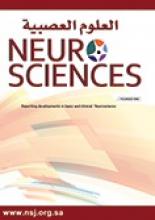Research ArticleOriginal Article
Open Access
Prevalence of epilepsy in Saudi pregnant women and possible effects of anti-epileptic drugs on pregnancy outcomes
Mona H. AlSheikh
Neurosciences Journal January 2020, 25 (1) 32-37; DOI: https://doi.org/10.17712/nsj.2020.1.20190077
Mona H. AlSheikh
From the Department of Physiology, College of Medicine, Imam Abdulrahman Bin Faisal University, Dammam, Kingdom of Saudi Arabia.
PhD
References
- ↵
- Fisher RS,
- Acevedo C,
- Arzimanoglou A,
- Bogacz A,
- Cross JH,
- Elger CE,
- et al.
- ↵
- Fiest KM,
- Sauro KM,
- Wiebe S,
- Patten SB,
- Kwon C-S,
- Dykeman J,
- et al.
- ↵
- Watila MM,
- Beida O,
- Kwari S,
- Nyandaiti NW,
- Nyandaiti YW
- ↵
- Morrell MJ,
- Montouris GD
- ↵
- Viale L,
- Allotey J,
- Cheong-See F,
- Arroyo-Manzano D,
- Mccorry D,
- Bagary M,
- et al.
- ↵
- Mawer G,
- Briggs M,
- Baker GA,
- Bromley R,
- Coyle H,
- Eatock J,
- et al.
- ↵
- Tomson T,
- Battino D
- ↵
- Güveli BT,
- Rosti RÖ,
- Güzeltaş A,
- Tuna EB,
- Ataklı D,
- Sencer S,
- et al.
- ↵
- Camfield P,
- Camfield C
- ↵
- Algahtani H,
- Shirah B,
- Alzahrani A,
- Shaheen M
- Fisher RS,
- Cross JH,
- French JA,
- Higurashi N,
- Hirsch E,
- Jansen FE,
- et al.
- ↵
- Neyaz HA,
- Aboauf HA,
- Alhejaili ME,
- Alrehaili MN
- ↵
- Shahid R,
- Nazish S,
- Zafar A,
- Aljafaari D,
- Alabdali M,
- Ishaque N,
- et al.
- ↵
- Viinikainen K,
- Heinonen S,
- Eriksson K,
- Kälviäinen R
- ↵
- Katz O,
- Levy A,
- Wiznitzer A,
- Sheiner E
- ↵
- Banerjee PN,
- Filippi D,
- Allen Hauser W
- ↵
- Sen G,
- Östlin P
- ↵
- Hamdy NA,
- Alamgir MJ,
- Mohammad EGE,
- Khedr MH,
- Fazili S
- ↵
- Battino D,
- Tomson T,
- Bonizzoni E,
- Craig J,
- Lindhout D,
- Sabers A,
- et al.
- ↵
- Patel SI,
- Pennell PB
- ↵
- Meador KJ,
- Baker GA,
- Browning N,
- Cohen MJ,
- Clayton-Smith J,
- Kalayjian LA,
- et al.
In this issue
Prevalence of epilepsy in Saudi pregnant women and possible effects of anti-epileptic drugs on pregnancy outcomes
Mona H. AlSheikh
Neurosciences Journal Jan 2020, 25 (1) 32-37; DOI: 10.17712/nsj.2020.1.20190077
Jump to section
Related Articles
- No related articles found.
Cited By...
- No citing articles found.





